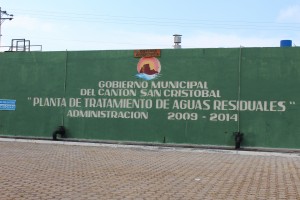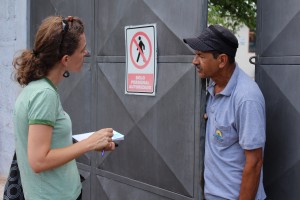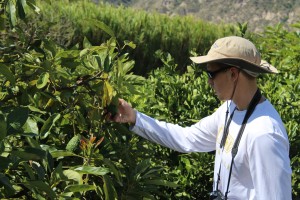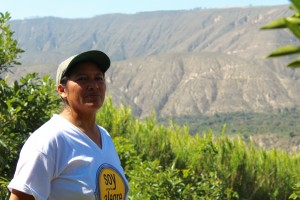Trip to the Sewage Treatment Plant on San Cristoóbal
Today our class got the chance to tour the sewage treatment plant for San Cristobal. And because water was such an important topic for our Local 2 Global class last semester, I made sure to take notes and pictures!
First of all, San Cristobal is the only island in the Galapagos that has a wastewater treatment plant. All the sewage from the other islands is discharged directly into the ocean. As you can imagine, this causes a lot of problems not only for the costal ecosystem but also the people who swim in the water. This might seem shocking to some readers who imagined the Galapagos as a pristine and well-managed socio-ecosystem (as I did).
So why does San Cristobal have the only wastewater treatment plant in the Galapagos? Like many other public projects in Ecuador, it has much to do with the behind-the-scenes politics. Since the island of San Cristobal contains the capital (and the mayor) of the whole Galapagos arphegio, it receives a lot of political attention from the mainland. And since the mayor of San Cristobal is in the same party as Ecuador’s president, the local government was easily able to secure the funds for the plant.
Because San Cristobal has a much smaller population (6,000) than most cities in the United States, they produce much less waste as well. Accordingly, the treatment plant was tiny compared to facilities I am used to seeing in the States. When we arrived there was only one worker managing the whole plant!
I have never been to a sewage treatment plant before so I was really interested to know what they did with the waste. I learned that when the water comes into the plant, it goes through an anaerobic and aerobic process before being treated with chemicals. Then the water is poured out into big concrete containment cells, and left to dry out. It faintly smelled like poop…
But the story continues! After about 3 months of drying, solid pieces of treated waste is mixed with organic compost waste produced from the residents of the island and used as a fertilizer.
Although it seemed like I was the only student who was really interested in the talk, I think it's good for all of us to know what happens to that wastewater when we flush the toilet. I believe that as environmentally responsible citizens it is important for us to know about the whole story of the inputs and outputs of our lives, especially our waste.
The Andean Dry Forest
A couple of weeks back, I took a class trip to an eco-farm called Hacienda Verde in the Andean dry forest, about 30 miles north of Quito. During our time there, I learned about some aspects of Ecuadorian rural culture and also how water is managed in Ecuador.
At the time, I was taking a class called Wildlife Conservation Management. The focus of the class was to investigate the goals and challenges of conserving wildlife, both plants and animals, in Ecuador. The eco-farm we visited turned out to be a perfect model of this kind of work. The mission of Hacienda Verde, taken from their website, is to create “a botanical garden of Andean fruits that will reflect the biodiversity of fruit species and varieties cultivated in Ecuadorian dry valleys.” Due to its geographical location on the equator, Ecuador’s climate is famous for producing a wide variety of fruits. It is also a big part of their economy. Bananas alone make up 61% of Ecuador agricultural GDP in 2009 (Global Agricultural Information Network 2011)
However, due to this commercialization of agriculture, many farmers have stopped growing many other native species of fruit in favor of the single, nationally recognized fruits. For instance, we all know what an avocado looks/tastes like. But did you know that there are at least 11 other species of avocados native to Ecuador? This is what our guide at Hacienda Verde told us, and showed us groves around the farm with different kinds of avocados. Other people interested in conserving the biodiversity of fruits in Ecuador have tried to record the different kinds of avocados. She told us we could pick some if we wanted; some of us stuffed our pockets as you can see from the picture below.
Most of these species ripen quickly, and thus, have to be consumed locally instead of being shipped for export. And since there is not much profit in these types of avocados, they are at risk of being lost from knowledge.
Hacienda Verde has a mission to bring these native fruits back into production by sustainably cultivating them on a small-scale. Through their work, they conserve many different types of native species. They also hire their laborers from the neighboring villages. One of the workers, María, accompanied us on our tour of the farm, showing us different plants and explaining their uses.
As a rural community, the culture is still highly influences by animistic beliefs. At one point, María went to go pick a fruit from a tree. She explained to us that you have to ask the plan’s permission before you take its fruit. One of the students in our group asked if the plan every said “no”. She responded (in Spanish) “no, it depends on your hands; if you have good hands”. Later, we heard one of the workers singing in the grove to the trees. María told us that the plants love to hear music because it has good energy. By the end of the day, it was very evident that there existed a mutual respect between the workers and the land.
You may be wondering how there can be a farm in a “dry forest”. While the farm itself is not a dry forest, it is part of the Jerusalem Dry Forest system, one of the last remnants of Andean dry forests in Ecuador. This dry forests, sited at 8,000feets above sea level, receives 23 inches of water a year, and experiences an average annual temperature of 63 o. Of course, farming is naturally infeasible in these conditions. However, canals built on the slopes of the neighboring mountains bring water to the farm from the Andean highlands. You can see the green vegetation line along the mountain in the picture below that brings water to the farm.
When I asked how the farm acquired this water, our tour guide gave us a little insight into how water is managed Ecuador:
“We are permitted to use the water, but we need to show that we are putting the water to good use.”
I thought that this sounded a lot like prior-appropriation water rights in the US, where the stakeholder is able to use water as long as he is putting it to a “reasonable use”. And since they are at the terminal of the canal, so they are most effected by any changes in the flow of the canal. Furthermore, if the canal needs maintenance, it’s a community effort to go out and fix it.
Overall, I was impressed by their great reverence toward the land and their good ecological work. Not only do they treat their farm with respect, they also are preserving the biodiversity of fruits in Ecuador against the threat of commercialization.

Here in Ecuador- January 26
Update: I'm safe and sound in Ecuador! This country is truly beautiful, with so many breathtaking landscapes.
This picture was taken from my weekend trip to a small city called Baños (and yes, that means bathroom in Spanish). It was named Baños after the natural hot springs that have formed there. And considering the theme of the class, it was only appropriate that I post a picture with water in it.
And speaking of water, I've learned a little bit about how water is managed here in Ecuador. I'm planning on writing a little post on it soon, so stay tuned!
Ama La Vida! (Love Life!)
Hello and welcome to my study abroad blog! My name is Don and I currently a junior at the University of Richmond. "Ama La Vida" or "Love Life" is the national slogan of Ecuador, the country I will be studying abroad next semester. And just to be sure, I have included a map below for those of you who don't know where Ecuador is. I will spend the first month of the semester in the capital, Quito, and then live the rest of the semester on the island of San Cristobal in the Galapagos Islands. As a Geography and Environmental Studies double major, I look forward to learning more about the relationship between people and the environment in Ecuador in my program with the Universidad San Francisco de Quito. Additionally, I will be using this blog to analyze a specific area of focus that you can read about below. Enjoy!

Ecotourism in the Galapagos
As I briefly mentioned above, my focus of inquiry while I am in Ecuador will be ecotourism. According to The International Ecotourism Society (TIES), ecotourism is defined as “responsible travel to natural areas that conserves the environment, sustains the well-being of the local people, and involves interpretation and education”. Briefly put, ecotourism is a branch of the tourism industry that specifically focuses on connecting people with the environment of a particular region. However, due to the unsustainable manner in which ecotourism has sometimes been carried out, it has a bad reputation as an environmentally destructive activity that also negatively impacts the local population. That’s why it’s important that ecotourism encompasses the three components TIES listed: conservation, communities, and education.
During my time abroad, I am going to look into how ecotourism plays out in the Galapagos Islands. More specifically, I am going to investigate how the ecotourism industry on the Galapagos balances the demands of the local communities with the conservation efforts of the National Park. Ecotourism is a vital part of the islands’ economy and keeps the various institutions on the islands up and running. Sometimes though, the environmental and financial demands of these islands push aside the needs of the people themselves. The island of San Cristobal, where I will be staying, has a population of 6,000 people who make their living from the natural resources that the islands produce. And there have been many conflicts between these communities and the National Park service as to how these resources should be allocated.
While I know these issues can be complex and difficult to unravel, I hope to learn more about them through the classes I take and my interactions with the galapageños themselves. Although I’m wary that I’ll be surrounded with other Americans in my program, I want to eventually break out of that bubble to reach out to the local people to talk to them about these issues (and I’m also hoping my Spanish improves). I hope that you will join me as I learn more about ecotourism and how it plays out in the Galapagos among these various stakeholders.
Community Engagement
In addition to study ecotourism on the islands, I will also be engaging with the community on the Galapagos through a volunteer program called Hacienda Tranquila. Click on button below to view a short overview of what Hacienda Tranquil is about and the kind of work they do





